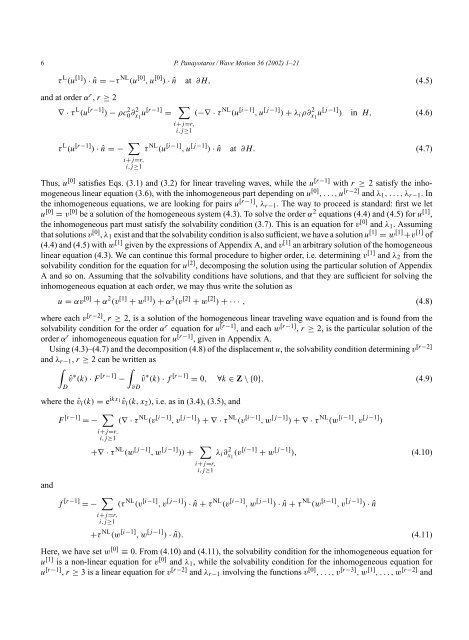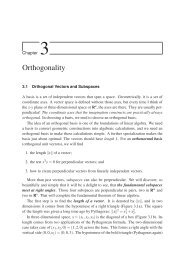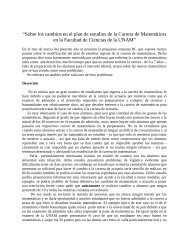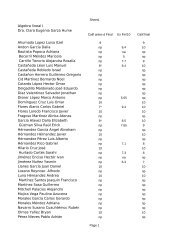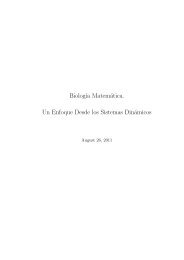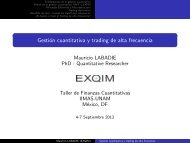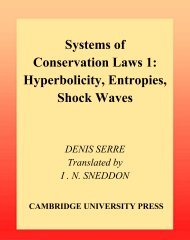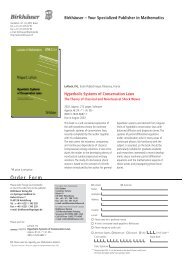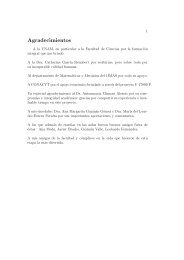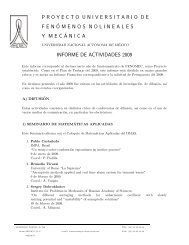An expansion method for non-linear Rayleigh waves - FENOMEC
An expansion method for non-linear Rayleigh waves - FENOMEC
An expansion method for non-linear Rayleigh waves - FENOMEC
Create successful ePaper yourself
Turn your PDF publications into a flip-book with our unique Google optimized e-Paper software.
6 P. Panayotaros / Wave Motion 36 (2002) 1–21τ L (u [1] ) ·ˆn =−τ NL (u [0] ,u [0] ) ·ˆn at ∂H, (4.5)and at order α r , r ≥ 2∇·τ L (u [r−1] ) − ρc0 2 ∂2 x 1u [r−1] =τ L (u [r−1] ) ·ˆn =− ∑i+j=r,i,j≥1∑i+j=r,i,j≥1(−∇ · τ NL (u [i−1] ,u [j−1] ) + λ i ρ∂ 2 x 1u [j−1] ) in H, (4.6)τ NL (u [i−1] ,u [j−1] ) ·ˆn at ∂H. (4.7)Thus, u [0] satisfies Eqs. (3.1) and (3.2) <strong>for</strong> <strong>linear</strong> traveling <strong>waves</strong>, while the u [r−1] with r ≥ 2 satisfy the inhomogeneous<strong>linear</strong> equation (3.6), with the inhomogeneous part depending on u [0] ,...,u [r−2] and λ 1 ,...,λ r−1 .Inthe inhomogeneous equations, we are looking <strong>for</strong> pairs u [r−1] , λ r−1 . The way to proceed is standard: first we letu [0] = v [0] be a solution of the homogeneous system (4.3). To solve the order α 2 equations (4.4) and (4.5) <strong>for</strong> u [1] ,the inhomogeneous part must satisfy the solvability condition (3.7). This is an equation <strong>for</strong> v [0] and λ 1 . Assumingthat solutions v [0] , λ 1 exist and that the solvability condition is also sufficient, we have a solution u [1] = w [1] +v [1] of(4.4) and (4.5) with w [1] given by the expressions of Appendix A, and v [1] an arbitrary solution of the homogeneous<strong>linear</strong> equation (4.3). We can continue this <strong>for</strong>mal procedure to higher order, i.e. determining v [1] and λ 2 from thesolvability condition <strong>for</strong> the equation <strong>for</strong> u [2] , decomposing the solution using the particular solution of AppendixA and so on. Assuming that the solvability conditions have solutions, and that they are sufficient <strong>for</strong> solving theinhomogeneous equation at each order, we may thus write the solution asu = αv [0] + α 2 (v [1] + w [1] ) + α 3 (v [2] + w [2] ) +··· , (4.8)where each v [r−2] , r ≥ 2, is a solution of the homogeneous <strong>linear</strong> traveling wave equation and is found from thesolvability condition <strong>for</strong> the order α r equation <strong>for</strong> u [r−1] , and each w [r−1] , r ≥ 2, is the particular solution of theorder α r inhomogeneous equation <strong>for</strong> u [r−1] , given in Appendix A.Using (4.3)–(4.7) and the decomposition (4.8) of the displacement u, the solvability condition determining v [r−2]and λ r−1 , r ≥ 2 can be written as∫∫ˆv ∗ (k) · F [r−1] − ˆv ∗ (k) · f [r−1] = 0, ∀k ∈ Z \{0}, (4.9)D∂Dwhere the ˆv i (k) = e ikx 1 ˆv i (k, x 2 ), i.e. as in (3.4), (3.5), andF [r−1] =− ∑(∇ ·τ NL (v [i−1] ,v [j−1] ) +∇·τ NL (v [i−1] ,w [j−1] ) +∇·τ NL (w [i−1] ,v [j−1] )andi+j=r,i,j≥1f [r−1] =− ∑+∇ · τ NL (w [j−1] ,w [j−1] )) + ∑i+j=r,i,j≥1i+j=r,i,j≥1λ i ∂ 2 x 1(v [i−1] + w [j−1] ), (4.10)(τ NL (v [i−1] ,v [j−1] ) ·ˆn + τ NL (v [i−1] ,w [j−1] ) ·ˆn + τ NL (w [i−1] ,v [j−1] ) ·ˆn+τ NL (w [i−1] ,w [j−1] ) ·ˆn). (4.11)Here, we have set w [0] ≡ 0. From (4.10) and (4.11), the solvability condition <strong>for</strong> the inhomogeneous equation <strong>for</strong>u [1] is a <strong>non</strong>-<strong>linear</strong> equation <strong>for</strong> v [0] and λ 1 , while the solvability condition <strong>for</strong> the inhomogeneous equation <strong>for</strong>u [r−1] , r ≥ 3 is a <strong>linear</strong> equation <strong>for</strong> v [r−2] and λ r−1 involving the functions v [0] ,...,v [r−3] ,w [1] ,...,w [r−2] and


